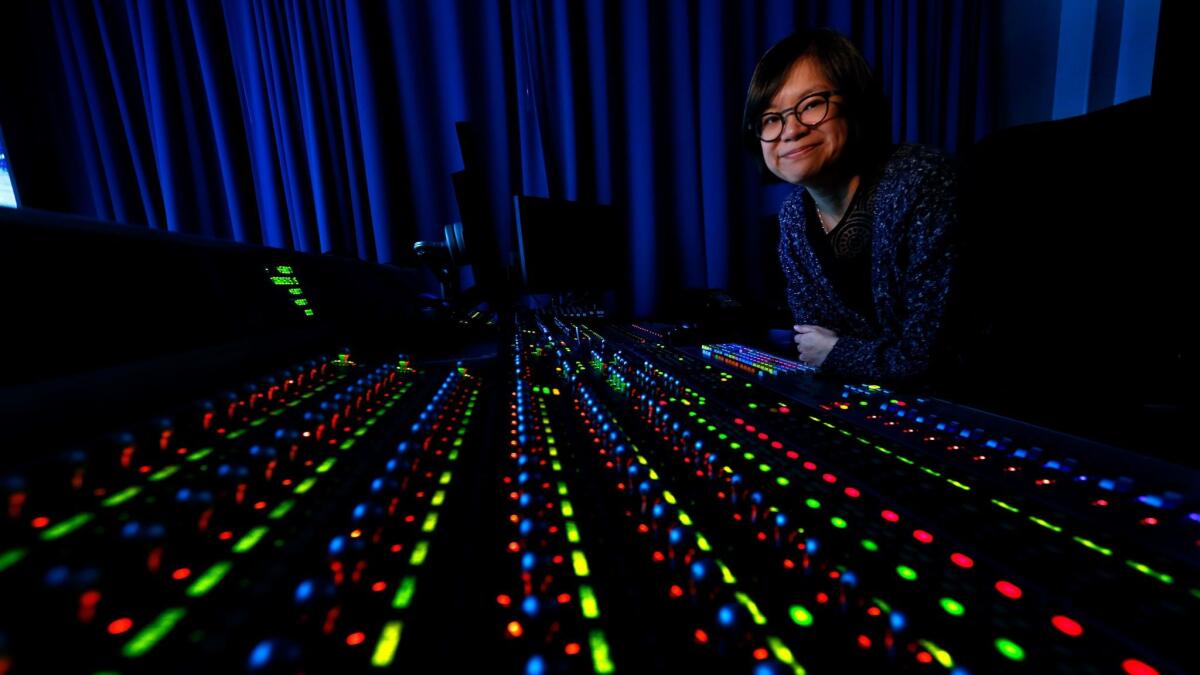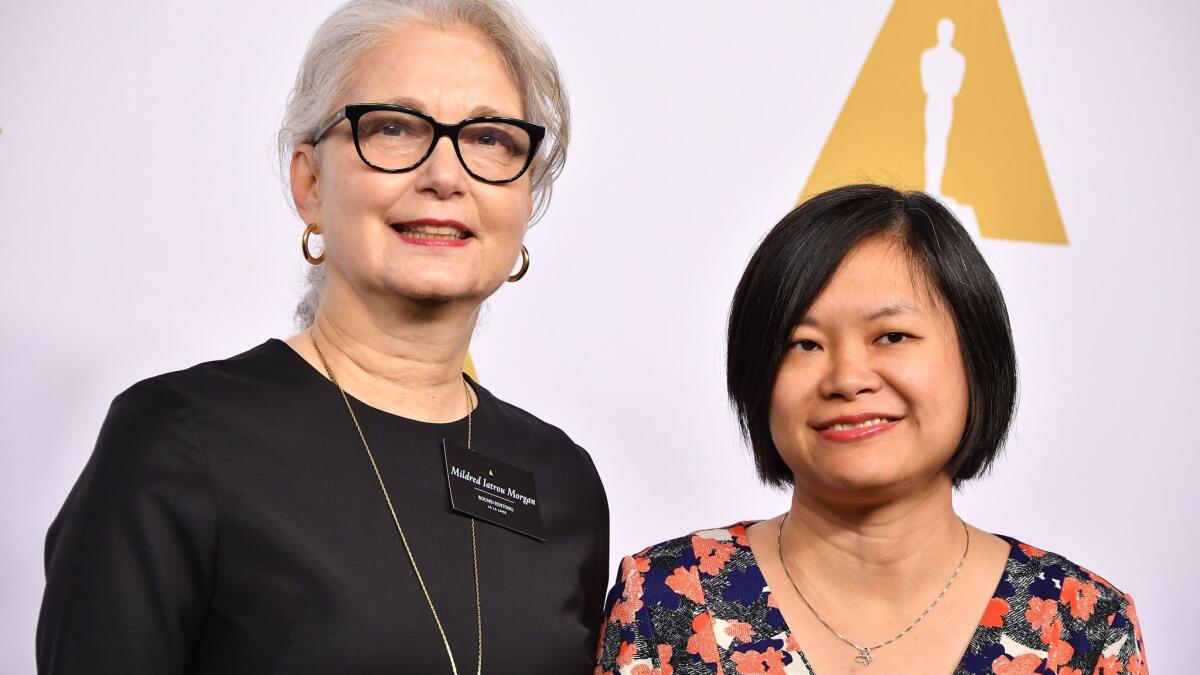‘La La Land’ sound mixer Ai-ling Lee makes Oscar history with an ‘invisible’ art . . . and car horns

In a landmark year for diversity at the Oscars, “La La Land’s” Ai-ling Lee has already made history — twice.
The Singapore-born Lee and Mildred Iatrou Morgan are the first all-woman sound editing duo ever to receive an Academy Award nomination. Additionally, Lee is part of the “La La Land” team nominated for the sound mixing trophy at Sunday’s ceremony.
With more than 70 feature films in her résumé, including “Watchmen,” “Rock of Ages” and “Man of Steel,” Lee, 38, is also the first Asian woman to be nominated for sound editing. And if she wins the Oscar for sound mixing with “La La Land” colleagues Andy Nelson and Steven Morrow, she would become only the second Asian winner in the category after “Slumdog Millionaire’s” Resul Pookutty, who won the award in 2009.
Lee’s double nominations are a huge achievement in a field dominated by men.
“There are really only a handful of women I am aware of,” she says, advising aspiring sound pros to find their specialties within the field. “I count myself as really lucky to be able to be doing this.”
Sound can heighten, and help bring the audience into a world.
— Ai-ling Lee, "La La Land" sound editor and mixer

Lee started her career working for a TV studio in Singapore, but the real La La Land beckoned. Writing unsolicited letters to Hollywood production companies and studio sound department heads, she introduced herself from halfway across the world. The initiative paid off. “I packed my bags and came here, and it took a while,” she says, “but I was fortunate enough to meet people willing to hire me.”
That was nearly 20 years ago. Some of Lee’s first credits came as a sound editor on films ranging from the music documentary “Buena Vista Social Club” to the Rob Schneider comedy “Deuce Bigalow: Male Gigolo,” specializing in sound effects editing. Last year also she contributed to 20th Century
“When he starts having those visions that make him charge toward his opponents and tackle people, we used crashing waves,” she laughs. “That’s what’s fun about sound: You might not use the most obvious sounds for what you see.”
Soundcraft, Lee says, “is an invisible kind of effect.”
Los Angeles is such a big character . . . You have music coming out from parts of the city — a car going by or Sebastian’s neighbor playing a mariachi song.
— Ai-ling Lee, "La La Land" sound editor and mixer
She fell in love with it as a child watching Hollywood action blockbusters with her audiophile father in Singapore. “We’d watch movies over and over again, like ‘Terminator 2’ and ‘Jurassic Park’ — I was amazed at how much sound can heighten, and help bring the audience into a world.”
Multiply that power by a thousand swoons in a musical like “La La Land,” writer-director Damien Chazelle’s Los Angeles-set ode to dreamers and Hollywood endings. “La La Land’s” thoroughly modern soundscape was designed to draw viewers into the springtime spark between jazz pianist Sebastian (
“Because Los Angeles is such a big character in the film, part of what Damien liked was to make use of sound to sell its liveliness, how it’s always bustling,” Lee says. “This is a musical, but you always also have music coming out from parts of the city — a car going by or Sebastian’s neighbor playing a mariachi song as he walks into his apartment.”
But the film’s sound design — distinct from its Oscar-nominated score and songs — also plays a crucial role in building the audience’s emotional connection to the leads. Take the dinner scene, in which audio cues subconsciously ebb and crescendo to emphasize the discord between Sebastian and Mia as a romantic date filled with music from a record player devolves into an argument and, eventually, into a silence that screams louder than words.
“You have this really rhythmic dialogue exchange that Damien had written, and we punctuated with some of the utensils so there’s almost a musicality to it,” Lee says. “By the point when they start yelling at each other, the music stops — almost signifying the end of their relationship.”
Not quite up on the difference between the academy’s two sound categories? Let Lee explain.

“I get asked this quite a bit,” she laughs. “You start with sound editing, taking the production dialogue recorded on set and cleaning it up so you don’t have any hiss and pop. Eighty percent of sound is added during sound editing — background sound, car doors, giant monster sounds, are all designed and recorded then. The sound editing team basically creates a palette of all of these sounds.”
Next, you move onto the sound mixing. “You take all that material and sift through them to see what is important to focus on,” Lee says. “It’s like when you’re watching a film and the camera is helping you focus on what’s onscreen. Here you do that with the sounds created by the editing team.”
In “La La Land,” Lee worked with Morgan, 61, to build a palette of sounds and effects that not only flowed in rhythm with Justin Hurwitz’s score, but matched it in pitch and tone. In the sound edit they created car horns in just the right key for the opening traffic jam number and recorded birds in Silver Lake, where Lee lives, to fold into the sonic geography.
They brought in choreographer Mandy Moore and a team of dancers to rerecord Gosling and Stone’s dance routine at dusk in Griffith Park, targeting a reference sound modeled after a dance number in the classic film musical “Top Hat.”
In the mix, Lee and co-nominees Andy Nelson and Steven Morrow wove all of their material together — including crucial live recordings of sung numbers like the show-stopping “Audition (Fools Who Dream).”
“It was almost like [Stone] was performing a monologue,” Lee says. “And as she was singing she’d get so emotional that after every take she’d be crying.”
More about “La La Land” . . .
Commentary: With a 'La La Land' sweep, Hollywood once more falls in love — with itself
ALSO
Samuel L. Jackson on Denzel, Viola, this year's Oscar race and his own 'Pulp Fiction' fight
UPDATES:
12:17 p.m. Feb. 22: A previous version of this story stated that Ai-Ling Lee is the first Asian to be nominated for a sound editing Oscar. She is the first Asian woman to be nominated in that category.
Only good movies
Get the Indie Focus newsletter, Mark Olsen's weekly guide to the world of cinema.
You may occasionally receive promotional content from the Los Angeles Times.








